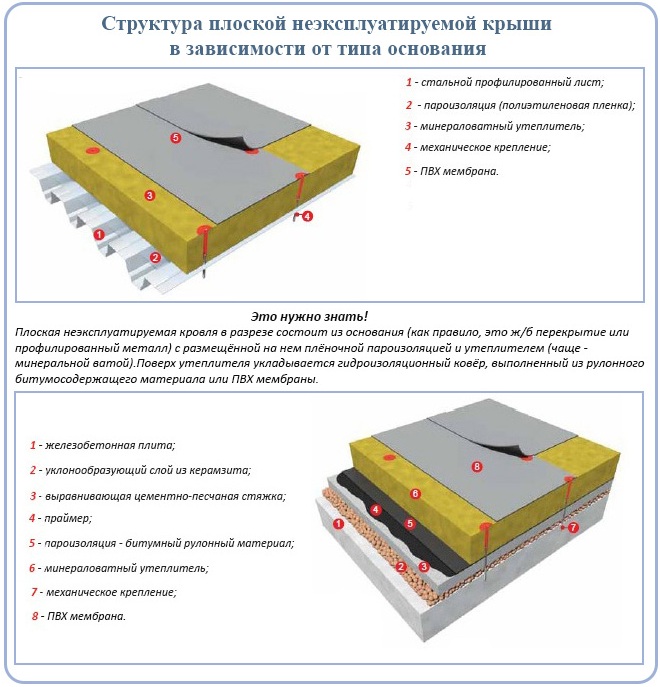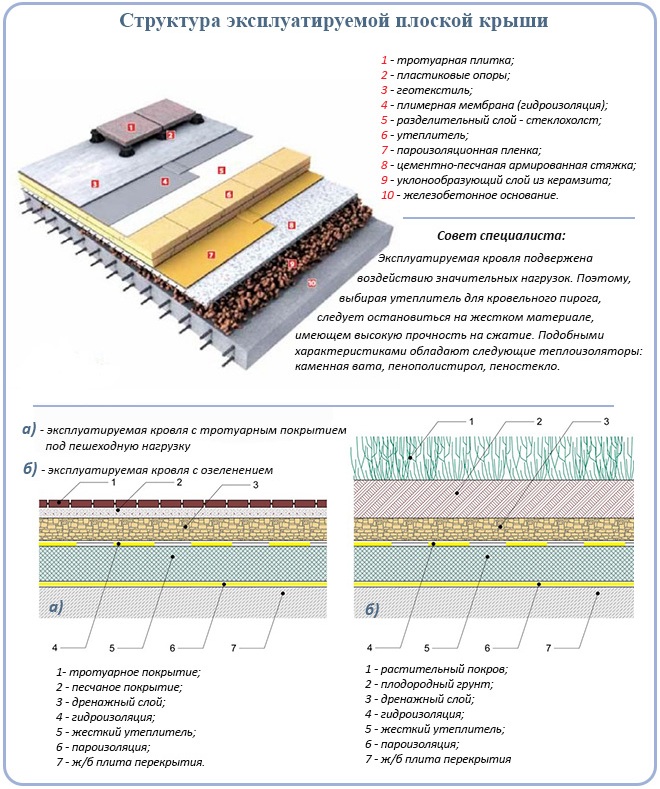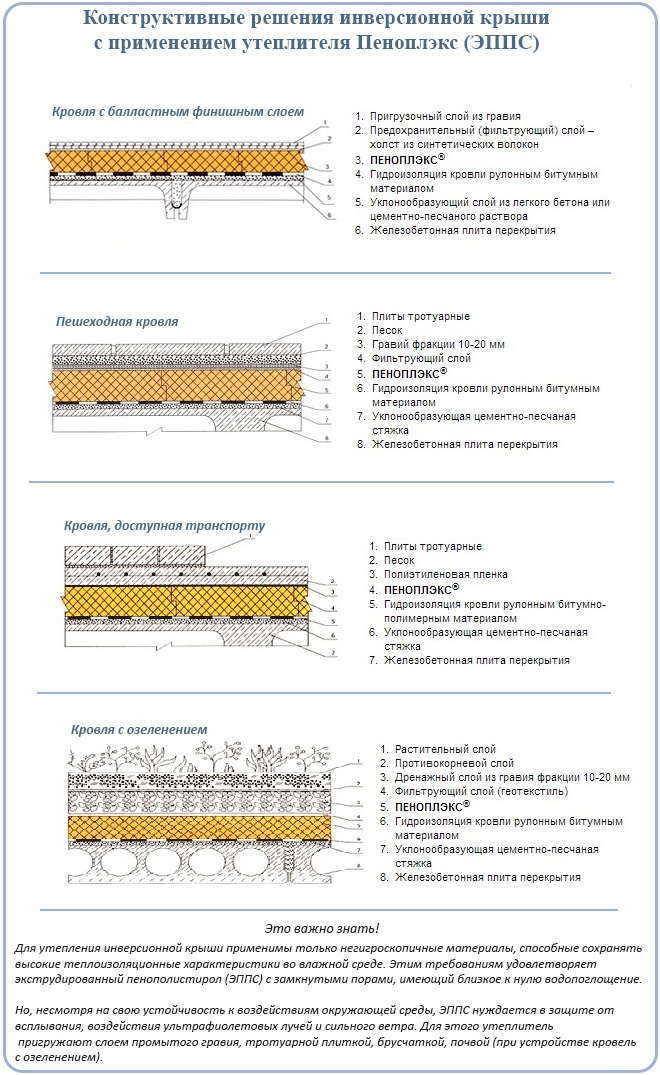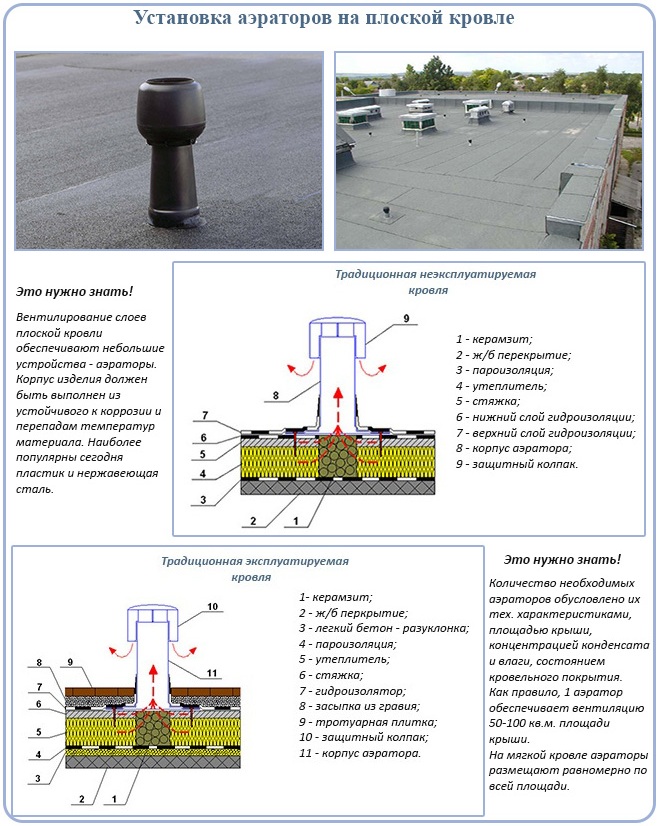More recently, a flat roof was considered the prerogative of monotonous urban high-rise buildings and industrial buildings. Now the situation has changed. More and more private developers are resorting to this architectural solution, trying to increase the useful area of \u200b\u200bthe house by arranging a terrace or an observation deck on the roof. Great perspective, right? But it can also become a real headache if the elements of a flat roof are selected or located incorrectly, in violation of the technologies recommended by experts. In order not to get into a mess, let's understand the structures of flat roofs, their components and the layered distribution of elements.
If any raised edges are present, wipe the area underneath. When the underside is dry, use hot to speed up the process. If it is necessary to apply mastic to an open area and press the ends of the crack, air bubble or border, with a roll of wallpaper paste. If the crack is difficult to close, use polyester tape or glitter tape to reinforce the repair. There are some spare roof leak repair materials on the market, even when wet or under water.
Instant sprays can be used on wet roofs as well as in grooves. You should check the manufacturer's instructions before using these products. If an insulated flat roof is severely damaged by a few cracks and blisters, it can be repaired by insulating with bituminous emulsion or waterproofing liquid.
Let's start with the basics. In fact, a flat roof only visually gives the impression of absolute horizontality. There is still a slight slope - 1-5 ° (1.7-8.7%). Visually and during operation, it is completely imperceptible, however, it allows atmospheric precipitation to flow freely to the catchment points - this is its main task.
Unlike pitched counterparts, a flat roof does not have a truss frame and, in fact, is a horizontal ceiling resting on the walls of the building. Its peculiarity is in the reinforced layers of heat and waterproofing, which are necessary due to the communication of the roof with the environment.
Before embarking on this task, you should thoroughly clean your roof deck with a fungicide to eliminate any mold. Repair and then cover the surface with emulsion or liquid. With a soft brush or broom spread out the product. Finally, wipe down the sponge with solvent to remove any leaks. Some bituminous emulsions require a device before the main coat. All liquid rubber products are applied in a single layer and offer greater durability due to greater flexibility.
When the layer of emulsion or liquid rubber dries, apply the stones. If the old chips are dirty or dull, add new ones. These stone shards keep the roofs cool when sunlight hits them. The connection between the flat roof and the wall of the house is usually damaged, allowing water to enter. To insulate this joint, you must insert lead tape into one of the wall's mortar layers. If, on the other hand, the lead tape is broken, the easiest way is to use bituminous adhesive tape.
The attractiveness of a flat roof for developers is justified by the following advantages:
- Reduced price. Compared to pitched roof, a flat analogue has a smaller area, respectively, the cost of materials is lower.
- Simplified installation and further maintenance. The arrangement of a flat structure is simpler than a pitched one, since it is easier to move along a horizontal plane than along an inclined one. For the same reason, various maintenance measures for the roof itself and the devices located on it (chimneys, fans, antennas, etc.) do not differ in complexity.
- The possibility of obtaining additional usable space(when the roof is in use). The surface of a flat roof can be easily used as a terrace, a walking platform and even ... a garden with a real lawn.
The main element of a flat roof is a solid base: reinforced concrete slabs, corrugated board or a solid surface of boards, plywood, OSB, DSP (when roofing on wooden beams). The very same roofing is made of several layers. Their number, location in the structure and materials of manufacture depend on the purpose of the roof and its type.
You must select the appropriate tape type for the task. Before starting this operation, you must clean the surfaces to be insulated and apply a tool before removing the paper. Press the tape first with your fingers and then with a roller. Use a heavy duty glove when performing this operation. If necessary, the tape can be cut with scissors. Place the fresh mortar on the joints where the duct tape is stuck to the wall of the house.
If the roof insulation is badly damaged, the most convenient solution is to re-insulate it. However, you should check if the structure below is in good condition to perform this type of operation. Usually simple sloping roofs it is easiest to insulate, for example, the roofs of garden sheds. Replacing a flat roof in a home extension or nearby garage is trickier, but with some effort and work, you can re-insulate yourself.

Types of flat roofs:
- Unexploited roof. The simplest, not carrying any additional functions, except for protecting the premises from environmental influences. It is not used for arranging places of recreational or household purposes. All that is required of it is a sufficient protective function, the ability to withstand snow and wind loads, as well as the weight of workers conducting maintenance activities. That is, during the construction of such a roof, the calculation is carried out on the fact that 1-2 people can be on it at the same time, and not constantly, but only for the period of maintenance and repair of the coating.
- Operated roof. It is equipped to perform some additional functions, except for directly roofing. For example, sports grounds, terraces, parking lots, lawns are planted and flower beds are laid out on exploited roofs.
- Inverted roof. It is characterized by an unconventional placement of layers - heat-insulating mats (EPS) are laid almost at the very top of the pie. Waterproofing is mounted under a layer of insulation. This solution helps to extend the life of the waterproofing coating, and, accordingly, the roof itself. Inverted roofs can be both operated (most often) and non-operated.
Flat roof pie structure
Each type of flat roof has its own design features, allowing you to apply specific materials and place layers in a specific sequence.
Flat roof characteristics
Roofing and roof coverings: getting free quotes. One might decide that a flat roof is not available, or is practical, or is circulating. It can also be turned into a plant roof, inaccessible except for Maintenance. The terrace can become a roof garden, just like a traditional garden, accessible to people with classic vegetation. You can also use synthetic turf or pebbles, economic materials. The flat roof has no frame but is based on a concrete, wood or metal supporting structure, but in most cases the roof terraces have a concrete slab structure, remember to slope 1 to 5% of the flat roof to evacuate rainwater.
Unexploited classic roof
The final layer of this type of roofing is a waterproofing coating: roofing felt, bituminous deposited materials, polymeric membranes, roofing mastic. Such a roof is not designed for a long stay of people and operation, and therefore the protection of the waterproofing layer is not provided.
At best, insulate cell glass and wood wool or fibers very durable materials. Gravel or gravel are the cheapest to protect the membrane. Also keep in mind a few other potential issues such as ventilation, storm drains, drainage, vapor barrier, sealing, regular inspection and maintenance.
What are the advantages and disadvantages of a flat roof?
Quote - What is the price in your city? With a flat roof, you have a large space, aesthetic that will develop, it will become like an extra room of your living environment, you can create details under the roof without wasting space. for installation in a planted roof or garden. Be sure to check the regulations in force in your area, but the main downside of a terrace roof is its waterproofing, which is more susceptible to leaking and leaking if the waterproofing hasn't been done well, so it's best to hire a professional.

It is also not necessary to use thermal insulation. Depending on the presence of this layer, non-exploited roofs are divided into insulated and non-insulated.
The insulated roof contains in its structure a heat-insulating layer protected by a vapor barrier (on the base side) and waterproofing (on the outside). Due to the presence of insulation, this type of roofing is used in the construction of many residential, civil and industrial buildings.
Roofing and roofing materials: Compare up to 5 quotes. When the roof of a flat roof is in poor condition and there are frequent leaks, the roof may need to be repaired. Sometimes this requires a complete reconstruction of the roof, and in other cases, replacing the roof is already sufficient. In this article, you can learn more about the upgrade or upgrade options and costs.
Repair a flat roof with bitumen
Bituminous coatings, also called roof coverings, are widely used due to long service life, limited maintenance and good value for money. For this reason, it does not need a protective covering layer. Neither type has a lower quality plan, but they do have their own specific applications.
The layers of the insulated unexploited roof are placed in the following sequence (the scheme may vary slightly):
- base;
- vapor barrier;
- insulation;
- waterproofing (roofing).
The basis of an insulated non-exploited roof is most often reinforced concrete slabs or a metal profile, less often a base made of boards, OSB, DSP, plywood on wooden beams. If necessary, the base is supplemented with a slope-forming layer that sets the direction of water flow from the roof. The slope is formed, as a rule, with bulk materials, a screed (concrete or expanded clay concrete).
- Long service life 30 years on average.
- Low maintenance requirements.
- Possibly finished with slate flakes.
- In some cases, it can be applied to an existing roof.
- Very long service life of 40 years on average.
- Does not require maintenance.
- Resilience resistant to root growth.
- Average service life is 20 years.
- A light weight.
- Can be healed without fire.
- Complex parts can be tightly closed.
- Root resistance.
On the base arranged in this way, a vapor barrier layer is mounted, which is used to protect the insulation from wet steam rising up from the side of the room. As a vapor barrier, you can use polyethylene and polypropylene films, glassine, roofing material. Next come 1-2 layers of insulating materials ( mineral wool, polystyrene, EPS), and on top of them - a waterproofing carpet made of bituminous materials or polymer membranes.
Additional costs for insulation and possibly the removal of old blanket and ballast layers should be considered. You can save money by doing some tasks yourself. When you compare quotes, take a close look at which ones are included and which ones are not. Compare prices and quotes, it's possible with our quote service.
When you are looking to upgrade or completely renovate a flat roof, you may want to consider a green roof because flat roofs have proven themselves well. Green roofs have been successful, especially among homeowners who want something other than a dull black finish or a layer of gravel. Therefore, companies that want to take on environmental responsibility are increasingly interested. A green roof is actually nothing more than a standard roof that has been modified to allow vegetation to grow.
An uninsulated unexploited roof is formed in a similar way, minus two layers - heat-insulating and vapor barrier, which are not needed in this option.
Applicable roofing layers:
- base;
- slope forming layer (if necessary);
- roofing.
Operated classic roof
More complex structure. It differs from the previous version by the presence of an upper durable layer, which serves to equip the operated site. Typically, this is used paving slabs, terrace board, gravel or crushed stone filling.
In most cases, these are plant species that are resistant to moisture and drought, such as grass, mosses, spices, or succulents. Special layers of vegetation and drainage have been applied on the green lid to allow this plant to grow well and help drain unwanted stormwater.
The roof is better protected from weather and temperature differences, which increases the life of the roof. Rooftop vegetation acts as thermal and acoustic insulation. Rainwater is discharged into the sewer, which reduces the rain load of the sewer.

The operated roof can be equipped both above the garage and above residential building. Accordingly, this design is insulated and non-insulated.
A common structure of the exploited insulated roof pie:
- base;
- slope forming layer (if necessary);
- vapor barrier;
- insulation;
- waterproofing;
- separating and filtering layer (geotextile);
- paving slabs for preparation.
One of the options for installing an insulated roof in operation (with detailed analysis all elements) is shown in the video:
A green roof looks natural and changes color over the years. Green roofs are environmentally friendly. Some cities subsidize green roof construction. This premium can be up to 30 euros per square meter. When the roof needs replacement, it's good to also turn to the insulation. You can save a lot of energy and at the same time protect your roof from temperature differences. Thus, the life of the roof is extended. There are two ways to insulate a flat roof.
Points of attention by repairing a flat roof
Hot roof In hot roof insulation, the roof covering rests on insulating materials. Rigid foam panels or other insulating material are often used. This insulation method is called "hot roof insulation". This is the most applicable insulation method and is used in situations where the old cover is in poor condition and needs to be removed. Reversible flat roof If the quality of the roof is still satisfactory and you only want to insulate, you can also choose "flat roof inverted". In this case, the insulating panels are installed over the existing cover and provided with a layer of ballast to keep them in place. The roof must support the weight of the ballast layer and the frame cannot be damaged. A flat flip roof is much cheaper than a hot roof because you don't need a new cover. The choice of roof finishing method and material depends on the load that the roof will face. It is advisable to periodically check the cornices and, if necessary, recycle them. In places where gravel tends to fly away, you can optionally place concrete back tiles, but watch out for sharp edges. They can damage the roof. Is there regular water on your roof? This means there is a problem with drainage. This can be corrected immediately during the repair.
- Above the roof cover is placed, eventually running out of gravel or tiles.
- Is there gravel on the roof?
An uninsulated exploitable roof does not contain thermal insulation. Accordingly, a vapor barrier film to protect the insulation is also not used here. Otherwise, the structure is identical to the above option.
Inverted roof
This is a special case of operated and non-operated insulated roofs. In classical roof structure the insulation is always covered on top with a waterproofing barrier.
Roof lanterns - a roof for flat roofs - are highly regarded by individuals and companies alike. AT residential areas light domes are an integral part of garages, sheds and shelters. Industrial buildings also receive light domes for better natural light penetration. This dome dome has a great advantage of being able to measure it.
Dome glass roof or plastic roof
Therefore, it can be integrated into any environment, for example as a dome of light over a greenhouse or as a glass dome over a large kitchen. In the past, roof domes or skylights were often made of plastic. Let's compare plastic domes and glass domes.
In an inverted roof, the layers are reversed. The waterproofing membrane is displaced under the thermal insulator. If in a conventional classical roof the waterproofing carpet protects the insulation, then in the inversion "changeling" - the opposite is true. Thermal insulation layer protects waterproofing.
Such a solution allows you to bypass one significant drawback of traditional roof structures: the rapid destruction of the waterproofing carpet from the influence of temperature changes, ultraviolet rays, atmospheric influences. Inverted roofs do not have this drawback; in their structure, the service life of the waterproofing carpet is much longer.

The layers of a flat roof of an inversion type are placed in this order:
- base;
- slope forming layer (if necessary);
- waterproofing;
- insulation;
- drainage layer;
- geotextile;
- protective finish layer - crushed stone or gravel ballast, tiles, decking, etc.
Device inverted roof perform according to the following principle. First, a waterproofing barrier is laid on the base, covered with insulation. Next comes drainage and geotextiles. The top layer performs a protective function, often it is made bulk.
In the structure of the inverted roof, the vapor barrier is not used. Accordingly, the insulation may suffer from steam coming from the interior. From above, the insulation is also not covered by anything from atmospheric precipitation (in traditional roofs, the protection function is performed by waterproofing, which in this version is hidden in the bottom layer of the pie). Therefore, special requirements are imposed on the insulation, first of all, minimal water and vapor absorption. Extruded polystyrene foam mats (EPS) have these characteristics - they are most often used in the structure of inverted roofs.

The steps for installing an inverted roof are shown in a training video from URSA:
Arrangement of the drainage system
As mentioned earlier, a flat roof is not completely horizontal, it is characterized by a slight slope (up to 5 °), which is used to install a drainage system.
The slope is formed in several ways:
- If the base of the roof is a reinforced concrete slab, then the slope is carried out using backfill materials (expanded clay, crushed stone, perlite), concrete and expanded clay concrete screed, and insulating plates.
- If the roof is laid on wooden beams, then the slope is provided either by the initial laying of the beams at a slight angle, or by additional installation of logs of different thicknesses with a slope in the required direction.
- When using profiled metal as a base, its laying is initially carried out under the required slope.
The slope is necessary for the equipment of gutters, which can be internal and external.
When arranging an internal drain, the slope is led to water intake funnels or fittings located on the roof surface. Their number and locations depend on the area of the roof, the conditions of its operation, the amount of precipitation in a particular area. As a rule, one funnel is mounted on 200-300 m 2 of the roof.
Inside each funnel there is a built-in filter that prevents leaves, branches, small animals from entering the drain. To prevent freezing of water, some models of funnels are equipped with self-regulating heat cables. They contribute to the unimpeded removal of atmospheric moisture even in winter, during thaws.
Internal drainage, as a rule, is used for large industrial buildings. In private construction, external drainage systems have become more widespread. In this case, the slope leads from the center of the roof to the edges, and drain holes (overflow windows) are installed at the corners of the parapet along with storm water inlets. It is recommended to supplement such a system with heating cables, since in winter there is a possibility of icing of storm water inlets and overflow windows.

Flat roof ventilation elements
Inside the premises where people live or work, water vapor constantly accumulates. It rises to the ceiling, cools, condenses and accumulates in the under-roof space. Moisture has a destructive effect on all layers of the roof - wood, metal and concrete. And accumulating in the insulation - gradually reduces its properties, increasing the cost of heating.
In order for wet vapors to escape from the roof structure, ventilation devices - aerators - are installed on a flat roof. They are plastic or metal pipes different diameters, covered from above with caps in the form of umbrellas.
On flat roofs aerators are evenly distributed over the entire area. It is recommended to put them at the highest points of the plane, where the insulation plates are joined. Usually, the installation of aerators is carried out during the construction of the roof, but it is also possible to do this during repairs. The main thing is that this measure will greatly increase the durability of the roof and insulation material.

In conclusion, I would like to note that all elements of the roof are equally important for its subsequent operation, and even if only one of them turns out to be unsuitable or is absent, the entire layered structure will suffer. Therefore, the choice of the type and quality of a complete set of a roofing pie must be taken with all responsibility.
